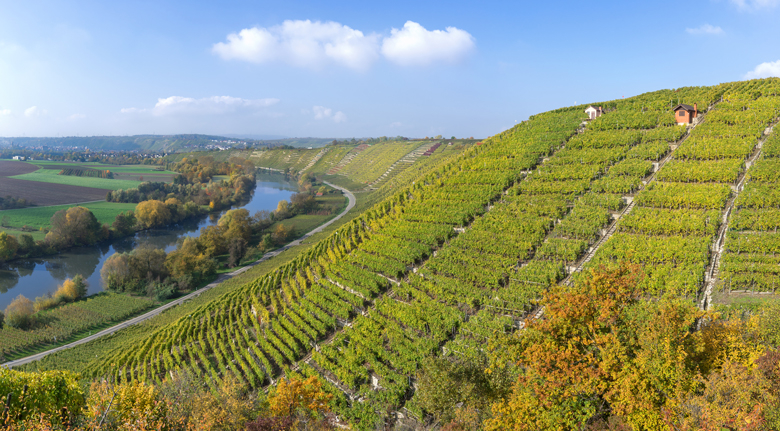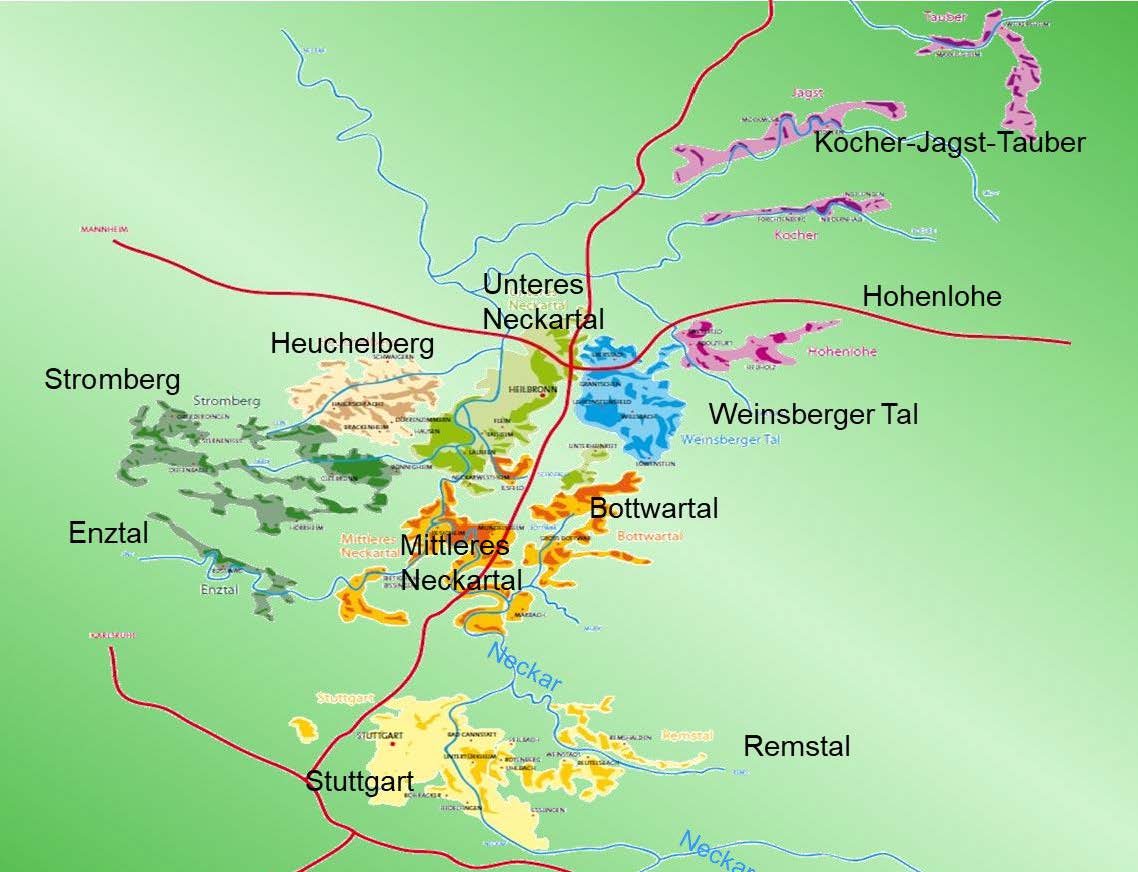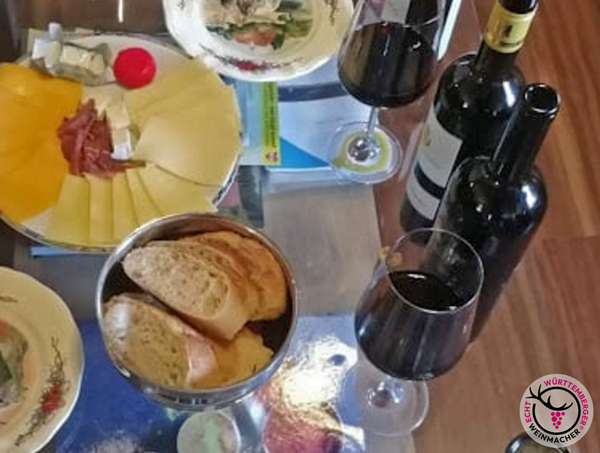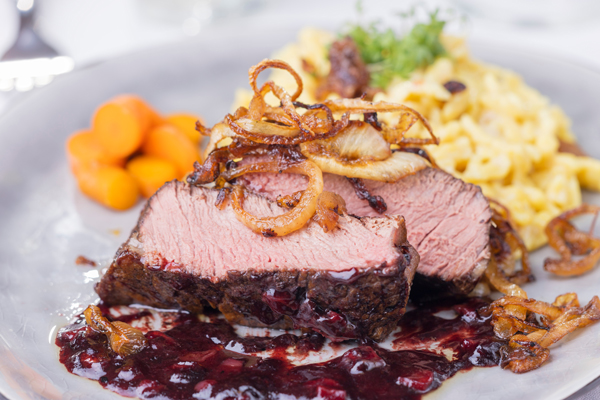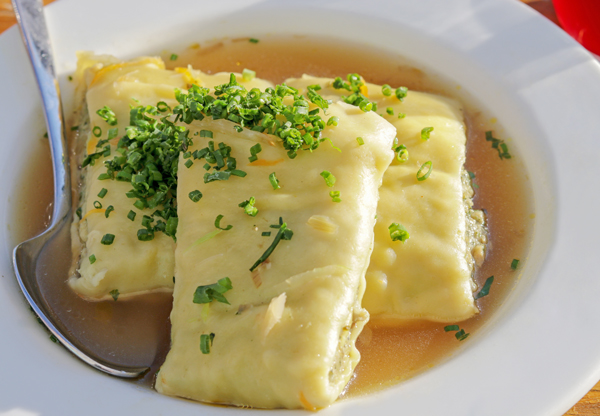The wine-growing district Wuerttemberg: A lot of good things and a worthwhile visit
Riesling, Trollinger, Lemberger, Schwarzriesling and much more ...
https://bonvinitas.com/media/reviews/photos/thumbnail/780x480c/0d/4a/79/the-wine-growing-district-of-wuerttemberg-a-lot-of-good-things-and-a-worthwhile-visit-32-1744712076.jpgThe Trollinger
The drinkable, not-too-heavy Trollinger red wines are simply as classic Wuerttemberg as anything. I tried a very nice one: the 2023 "Sankt M" Trollinger dry red wine, a Wuerttemberg quality wine, 12% alcohol, from the Cleebronn-Güglingen winegrowers. My notes: Lively aroma with notes of currant jelly and sour cherry jam; spicy body with a fine temperament, subtle tannins, and a hint of cloves; a smooth, stimulating finish. Perfect with pasta dishes, sausage sandwiches, or as a terrace wine, and of course, a classic with Gaisburger Marsch—more on that below.
Around the Neckar
Overall, Wuerttemberg is Germany's fourth-largest wine-growing region, with approximately 11,300 hectares. The vines are found primarily along the Neckar River between Ludwigsburg and Neckarsulm, particularly around Heilbronn, as well as west of it in the Heuchelberg and Stromberg hills, further in and around Stuttgart inclusive the Remstal valley, and also in patches near the Lake Constance. The two maps (click to enlarge) provide the full details. The soils are predominantly Jurassic, shell limestone and Keuper, as well as colorful marl and loess. The limestone and Keuper soils, in particular, are reflected in the minerality of many wines.
Riesling in the foreground
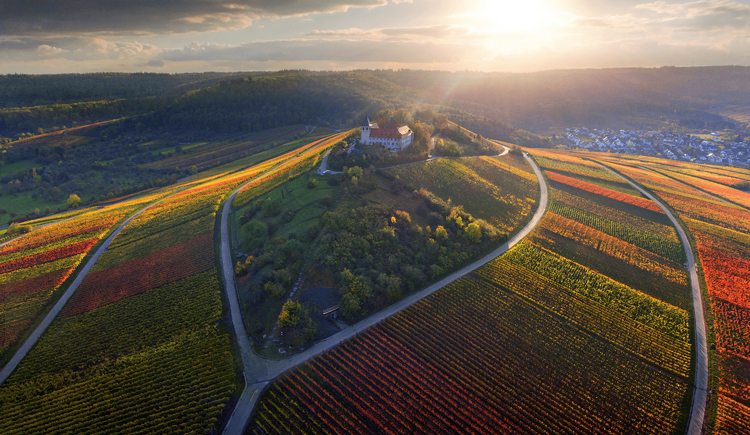
 With over 2,100 hectares, Riesling reigns supreme. Here, too, the Cleebronn-Güglingen winegrowers sent me a very nice, pleasantly light wine: 2024 "Sankt M" Riesling dry, quality wine from Württemberg . The color is a vibrant light green; the nose is of fresh white peaches, candied lemon peel, and a hint of caramel; a very clean qand appealing body that almost takes you for a stroll; a beautifully rounded finish with a hint of salt; a wine that's simply enjoyable, and at just 11.5% alcohol—a wine you can easily drink another glass of. It's a great aperitif and well with smoked fish, mussels, or lighter meat dishes like veal liver, and of course with Swabian Ravioli. I 've awarded it 90 green bonvinitas points (green = Category 1, light, dry wines up to 12% ABV – this is our rating system for blind reviews for the bonvinitas wine guide, which I'm also using for my reports, which represent in this case my own opinion). I'd like to emphasize excellent light wines that always give me particular pleasure. Cleebronn, by the way, is located in the Zabergäu of the Heuchelberg region. The vines there grow primarily around the Michaelsberg.
With over 2,100 hectares, Riesling reigns supreme. Here, too, the Cleebronn-Güglingen winegrowers sent me a very nice, pleasantly light wine: 2024 "Sankt M" Riesling dry, quality wine from Württemberg . The color is a vibrant light green; the nose is of fresh white peaches, candied lemon peel, and a hint of caramel; a very clean qand appealing body that almost takes you for a stroll; a beautifully rounded finish with a hint of salt; a wine that's simply enjoyable, and at just 11.5% alcohol—a wine you can easily drink another glass of. It's a great aperitif and well with smoked fish, mussels, or lighter meat dishes like veal liver, and of course with Swabian Ravioli. I 've awarded it 90 green bonvinitas points (green = Category 1, light, dry wines up to 12% ABV – this is our rating system for blind reviews for the bonvinitas wine guide, which I'm also using for my reports, which represent in this case my own opinion). I'd like to emphasize excellent light wines that always give me particular pleasure. Cleebronn, by the way, is located in the Zabergäu of the Heuchelberg region. The vines there grow primarily around the Michaelsberg.
Also typical of Wuerttemberg: Lemberger
Lemberger produces powerful, full-bodied, round red wines. The variety originally came from Austria, where it is called Blaufraenkisch. It was probably brought from the Austrian town Limberg, hence the name. In Germany, it grows primarily in Wuerttemberg, where it ranks third with approximately 1,750 hectares.

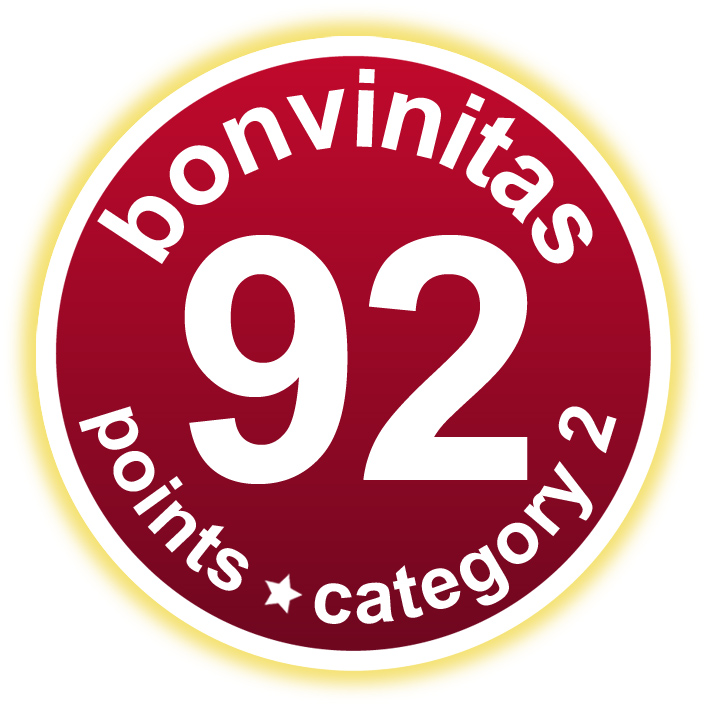 The Lauffen Winegrowers submitted a very good one to me : 2022 'Josua' Lemberger dry, quality wine from Wuerttemberg, 14% : Powerful nose with plenty of cassis, plum jam, dark chocolate, a hint of toast, and a touch of eucalyptus; on the palate a very intense red wine with further toasted notes, ripe tannins, and a hint of black pepper; very well-balanced length, with the toast and eucalyptus touches reappearing—very harmonious with plenty of potential and a great match for the famous Swabian roast beef with onions, grilled steaks, or venison goulash. 92 bonvinitas points !
The Lauffen Winegrowers submitted a very good one to me : 2022 'Josua' Lemberger dry, quality wine from Wuerttemberg, 14% : Powerful nose with plenty of cassis, plum jam, dark chocolate, a hint of toast, and a touch of eucalyptus; on the palate a very intense red wine with further toasted notes, ripe tannins, and a hint of black pepper; very well-balanced length, with the toast and eucalyptus touches reappearing—very harmonious with plenty of potential and a great match for the famous Swabian roast beef with onions, grilled steaks, or venison goulash. 92 bonvinitas points !
What would Wuerttemberg be without Schwarzriesling
The red variety grows in Germany with around 70% of its production in Wuerttemberg, where it ranks fourth. The grape is also called Muellerrebe, and in France, Meunier, where it grows primarily in the Champagne region and contributes a significant portion of the grapes used to make classic Champagne, in this case, of course, as Blanc de Noir.
 I really liked the 2020 "Weinwerkstatt" Schwarzriesling Barrique dry, quality wine Wuerttemberg, 14.5%, also from the Lauffen Winegrowers : a calm, wonderfully harmonious aroma with notes of cherry compote, blackberries, and dark chocolate; on the tongue, an explosion of fruit accompanied by toasted notes and memories of oak with a touch of white pepper; very harmonious length with a beautiful balance between fruit and tannins, fits well with roast beef and, of course, Swabian onion roast beef, as well as with game or veal liver. 91 bonvinitas points !
I really liked the 2020 "Weinwerkstatt" Schwarzriesling Barrique dry, quality wine Wuerttemberg, 14.5%, also from the Lauffen Winegrowers : a calm, wonderfully harmonious aroma with notes of cherry compote, blackberries, and dark chocolate; on the tongue, an explosion of fruit accompanied by toasted notes and memories of oak with a touch of white pepper; very harmonious length with a beautiful balance between fruit and tannins, fits well with roast beef and, of course, Swabian onion roast beef, as well as with game or veal liver. 91 bonvinitas points !  Lauffen lies on a bend in the Neckar with steep slopes, where limestone cliffs 'stand guard' leading down to the Neckar Valley, where they are called Felsengärten (rock gardens) near Hessigheim. The vineyard site in the photo is called Katzenbeisser (Cat-biter) because the wine prices literally tore a hole in the walltet (because the wallets were called money cats in those days).
Lauffen lies on a bend in the Neckar with steep slopes, where limestone cliffs 'stand guard' leading down to the Neckar Valley, where they are called Felsengärten (rock gardens) near Hessigheim. The vineyard site in the photo is called Katzenbeisser (Cat-biter) because the wine prices literally tore a hole in the walltet (because the wallets were called money cats in those days).
Many wines, information and events at 'Echt Wuerttemberger'
Many wines and information with links can be found at www.echt-wuerttemberger.de. It includes 24 wine cooperatives, which produce around 70% of the Wuerttemberg wines. The site also features numerous events and wine tastings.
What would Wuerttemberg be without the famous Swabian onion roast beef and other specialties
 The red wines mentioned are fitting particularly well with Swabian onion roast beef, classic roast beef with roasted onions and spaetzle, and together they convey a real Swabian feeling.
The red wines mentioned are fitting particularly well with Swabian onion roast beef, classic roast beef with roasted onions and spaetzle, and together they convey a real Swabian feeling.
Other specialties include the famous Maultaschen (Swabian Ravioli), pasta dumplings with a basic filling of sausage meat, onions, and soaked bread rolls, served in a clear broth, which fits perfectly with a Riesling. A true specialty is the Gaisburger Marsch, a traditional Swabian stew with potatoes, spaetzle, and beef, all in beef broth with soup greens, and also with vegetables like carrots, which fits most perfectly with Trollinger. The name Gaisburger Marsch, incidentally, comes from the Stuttgart district Gaisburg.
Special highlights

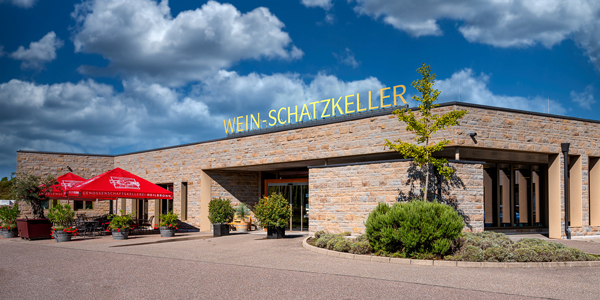
If you travel to Swabia, one of the highlights is of course the state capital and wine-producing city of Stuttgart, where the vineyards extend right to the edge of the city. Top destinations there are the Mercedes-Benz and Porsche museums. Other tempting options include shopping, relaxed evenings and plenty of culture. Another highlight is the wine-producing city of Heilbronn, which is largely surrounded by vineyards. bonvinitas already released a nice article about Heilbronn and what there is to experience in terms of wine. Other recommended destinations are Ludwigsburg Palace and the picturesque town Tuebingen, which is also home to wine. The Tripsdrill adventure park, which has a treehouse hotel, is even surrounded by vineyards .
Leisure cycling on the Wuerttemberg Wine Cycle Route
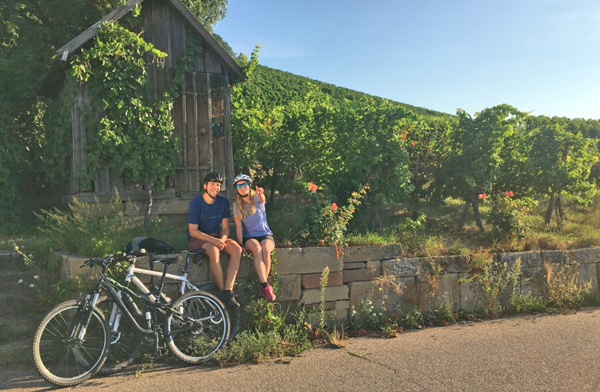 Of course, there's also a wine route by cars, but if you want to experience the Wuerttemberg wine-growing region up close, hop on a bike. Vines cling to the mountainside on both sides of the path, where vine leaves rustle in the wind and lizards scurry about. Along the mostly paved paths, wine cooperatives and numerous wine taverns invite you to stop and enjoy a drink.
Of course, there's also a wine route by cars, but if you want to experience the Wuerttemberg wine-growing region up close, hop on a bike. Vines cling to the mountainside on both sides of the path, where vine leaves rustle in the wind and lizards scurry about. Along the mostly paved paths, wine cooperatives and numerous wine taverns invite you to stop and enjoy a drink.
The entire Wuerttemberg Wine Cycle Route measures 396 km. However, individual stages or shorter distances can also be explored individually – more information here.Package tours of eight or nine days with overnight stays are even available for the entire route .
Wuerttemberg wine hiking trails
 At Tourismus Marketing GmbH Baden-Württemberg you will find a total of 137 local suggestions, as well as the large Württemberg Wine Hiking Trail, a long-distance hiking trail of the Swabian Alb Association, which stretches from Aub in Bavarian Franconia to the former imperial city of Esslingen on Neckar with a total of 313 km.
At Tourismus Marketing GmbH Baden-Württemberg you will find a total of 137 local suggestions, as well as the large Württemberg Wine Hiking Trail, a long-distance hiking trail of the Swabian Alb Association, which stretches from Aub in Bavarian Franconia to the former imperial city of Esslingen on Neckar with a total of 313 km.
Text: Dieter Simon, publisher and editor-in-chief of bonvinitas; photos as indicated, otherwise PR.
